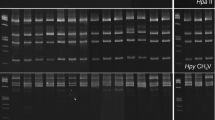Abstract
A European quarantine organism ‘Candidatus Phytoplasma pyri’ causing devastating pear decline disease has been reported to affect pear trees in several European countries. In this study a multilocus sequence analysis was successfully used to gain detailed insight into the molecular diversity of thirty closely related ‘Candidatus Phytoplasma pyri’ isolates from different orchards in Slovenia. Among three genomic regions analyzed, the 16S/23S rRNA intergenic spacer region was the most conserved among Slovenian isolates with 99.7 % sequence identity, yielding only three distinct genotypes. On the other hand, five different genotypes were detected when analyzing secY and aceF genomic regions that shared sequence identity of 94.8 and 97.2 %, respectively. Six of the detected genotypes, specifically four in the secY region and one in each of the two other analyzed genomic regions, were unique for Slovenia. At least eight different haplotypes were found with multilocus sequence analysis, indicating high molecular diversity among Slovenian ‘Ca. P. pyri’ isolates. Haplotypes were clustered into two major clusters, separated by at least 45 mutations. No connection was established between haplotype occurrence and cultivar type.


Similar content being viewed by others
References
Bertaccini, A. (2007). Phytoplasmas: diversity, taxonomy, and epidemiology. Frontiers in Bioscience, 12, 673–89.
Casati, P., Quaglino, F., Stern, A. R., Tedeschi, R., Alma, A., & Bianco, P. A. (2011). Multiple gene analyses reveal extensive genetic diversity among ‘Candidatus Phytoplasma mali’ populations. Annals of Applied Biology, 158(3), 257–266.
Ciccotti, A. M., Bianchedi, P. L., Bragagna, P., Deromedi, M., Filippi, M., Forno, F., et al. (2007). Transmission of ‘Candidatus Phytoplasma mali’ by root bridges under natural and experimental conditions. Bulletin of insectology, 60(2), 387–388.
Danet, J. L., Blakishiyeva, G., Cimerman, A., Sauvion, N., Marie-Jeanne, V., Labonne, G., et al. (2011). Multilocus sequence analysis reveals the genetic diversity of european fruit tree phytoplasmas and supports the existence of inter species recombination. Microbiology, 157(2), 438–450.
Deng, S., & Hiruki, D. (1991). Amplification of 16S rRNA genes from culturable and nonculturable mollicutes. Journal of Microbiological Methods, 14, 53–61.
Fránova, J., Ludvíková, H., Paprštein, F., & Bertaccini, A. (2013). Genetic diversity of Czech ‘Candidatus Phytoplasma mali’ strains based on multilocus gel analyses. European Journal of Plant Pathology, 136(4), 675–688.
Kube, M., Schneider, B., Kuhl, H., Dandekar, T., Heitmann, K., Migdoll, A. M., et al. (2008). The linear chromosome of the plant-pathogenic mycoplasma ‘Candidatus Phytoplasma mali’. BMC Genomics, 9, 306. doi:10.1186/1471-2164-9-306.
Lee, I.-M., Zhao, Y., Davis, R. E., Wei, W., & Martini, M. (2007). Prospects of DNA-based system for differentiation and classification of phytoplasmas. Bulletin of Insectology, 60(2), 239–244.
Lorenz, K.-H., Schneider, B., Ahrens, U., & Seemüler, E. (1995). Detection of the apple proliferation and pear decline phytoplasmas by PCR amplification of ribosomal and non ribosomal DNA. Phytopathology, 85(7), 771–776.
Maček, J. (1986). Posebna fitopatologija. Patologija sadnega drevja in vinske trte. Ljubljana: Universitiy of Ljubljana.
Mehle, N., Nikolić, P., Rupar, M., Boben, J., Ravnikar, M., & Dermastia, M. (2013) Automated DNA extraction for large numbers of plant samples. In: M. Dickinson (Ed.), J. Hodgetts (Ed.). Phytoplasma: Methods and Protocols. Methods in Molecular Biology, 938, Springer Protocols (pp. 139-145). New York: Humana press.
Mehle, N., Ravnikar, M., Seljak, G., Knapič, V., & Dermastia, M. (2011). The most widespread phytoplasmas, vectors and measures for disease control in Slovenia. Phytopathogenic Mollicutes, 1(2), 65–76.
Nikolić, P., Mehle, N., Gruden, K., Ravnikar, M., & Dermastia, M. (2010). A panel of real-time PCR assays for specific detection of three phytoplasmas from the apple proliferation group. Molecular and Cellular Probes, 24(5), 303–309.
Pedrazzoli, F., Filippi, M., Deromedi, M., Bragagna, P., Battocletti, I., Bianchedi, P. L., et al. (2008). Apple proliferation transmission by grafting in different periods of the year. Acta Horticulturae, 781, 489–493.
Schneider, B., & Seemüller, E. (2009). Strain differentiation of ‘Candidatus Phytoplasma mali’ by SSCP- and sequence analyses of the hflB gene. Journal of Plant Pathology, 91(1), 103–112.
Seemüller, E., Kampmann, M., Kiss, E., & Schneider, B. (2011). HflB gene-based phytopathogenic classification of ‘Candidatus Phytoplasma mali’ strains and evidence that strain composition determines virulence in multiply infected apple trees. Molecular Plant-Microbe Interactions, 24(10), 1258–1266.
Seemüller, E., & Schneider, B. (2007). Differences in virulence and genomic features of strains of ‘Candidatus Phytoplasma mali’, the apple proliferation agent. Phytopathology, 97(8), 964–970.
Smart, C. D., Schneider, B., Blomquist, C. L., Guerra, L. J., Harrison, N. A., Ahrens, U., et al. (1996). Phytoplasma-specific PCR primers based on sequences of the 16S-23S rRNA spacer region. Applied and Environmental Microbiology, 62(8), 2988–2993.
Wei, W., Davis, R. E., Lee, I. M., & Zhao, Y. (2007). Computer-simulated RFLP analysis of 16S rRNA genes: identification of ten new phytoplasma groups. International Journal of Systematic and Evolutionary Microbiology, 57(8), 1855–1867.
Weintraub, P. G., & Beanland, L. (2006). Insect vectors of phytoplasmas. Annual Review of Entomology, 51, 91–111.
Acknowledgments
This work was supported by the Slovenian Research Agency grant P4-0165. The authors thank phytosanitary inspectors for providing the samples and Dr. Elizabeth Covington for critical reading of the manuscript.
Author information
Authors and Affiliations
Corresponding author
Electronic supplementary material
Below is the link to the electronic supplementary material.
Supp. Fig. 1
(DOCX 191 kb)
Supp. Fig. 2
(DOCX 931 kb)
Supp. Fig. 3
(DOCX 523 kb)
Supp. Fig. 4
(DOCX 474 kb)
Rights and permissions
About this article
Cite this article
Jernej, P., Nataša, M., Petra, N. et al. Molecular diversity of ‘Candidatus Phytoplasma pyri’ isolates in Slovenia. Eur J Plant Pathol 139, 801–809 (2014). https://doi.org/10.1007/s10658-014-0434-5
Accepted:
Published:
Issue Date:
DOI: https://doi.org/10.1007/s10658-014-0434-5




